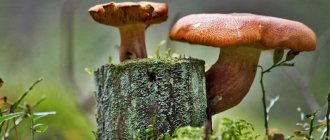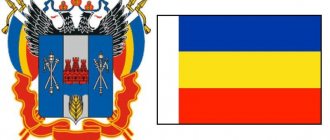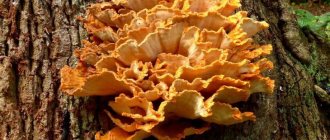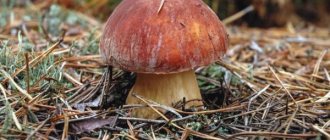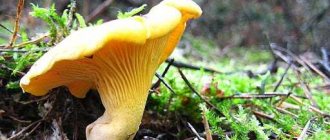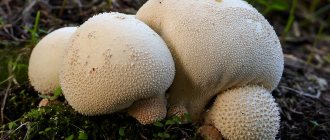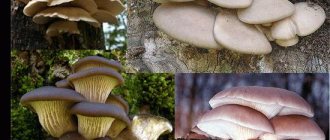The circle of mushrooms (fairy ring, elf circle, witch circle) is a natural phenomenon. The mushrooms create a ring or arc in the soil and grow through the grass to form a circle. Some consider these rings to be a good omen, others - a bad omen.
For thousands of years, the sudden appearance of a circle of mushrooms was considered a sure sign of the presence of otherworldly forces. These rings appeared seemingly overnight, sometimes moving from place to place for unknown reasons.
Stories about the dark forces that were believed to create these anomalies were passed down from generation to generation. Many legends and tales have been created about these magic rings.
Grass in a circle. Licorne37/wikimedia.org/Public domain
The size of these circles varies from a few centimeters in diameter to 50 meters or more. The ring of mushrooms in Belfort, France, is believed to be the largest ever found. It is approximately 600 meters in diameter and is 700 years old.
Sometimes there may be several rings, they overlap each other, creating strange, twisting patterns in the grass. Often the grass inside the circle is dried out or a different color than the outside.
What it is?
These objects are also called fairy circles, elf circles or elf rings. In fact, this is a natural phenomenon. The fungi create a ring or arc-shaped structure in the soil, affecting the grass in the area. They grow in the greenery, forming a circle of mushrooms.
These rings are a pleasant surprise and good fortune for some, or a dark omen and troublesome problem for others. They can extend from a few centimeters to 50 meters or more. The ring found in Belfort (France) is believed to be the largest ever discovered. It has a diameter of 600 meters and appears in this place for 700 years.
Sometimes there will be more than one ring in a space and they will overlap, creating strange, twisting patterns in the grass. Often the grass inside the ring is dead and dried out and a different color than the grass outside.
The British trusted Arnold Schwarzenegger to save the Earth from aliens
“Muffin top”: how to get rid of fat accumulation in the abdominal area
Why did Olga Skabeeva instantly become popular? 4 principles that she does not change
Reasons for the appearance of mushrooms on the lawn
There can be many reasons why mushrooms may grow on a fresh lawn. It is important to identify them before using any fungicidal agents, so as not to introduce harmful chemicals into the soil in vain.
Did you know? A unique attraction of the national park in Ofenpass (Switzerland) is the mycelium of the honey fungus, the total area of which is 40 hectares (800×500 m).
Some of the most common reasons why mushrooms appear on the lawn include the following:
- A lawn that was too cheap was purchased, created from low-quality mixtures of grasses and flowers. Quite often, such a product contains mycelium, that is, a ready-made mycelium. In addition, experts note that most often the appearance of mushrooms occurs when purchasing a rolled lawn.
- Often, a similar problem arises with frequent watering of the area, which provokes stagnation of water in the upper layers of the soil and, as a consequence, the active development of spores, which leads to the growth of fungi. A similar situation can occur due to the constant contact of animal urine on the grass.
- Some experts do not recommend laying peat soil under the lawn, since this creates a lot of moisture under the lawn, which can also be an impetus for the development of mycelium.
- The simplest and most common cause of this problem is the immediate proximity of the site to the forest, or to various mycelium-infected plants (fruit trees, less often shrubs) that grow near the lawn within a radius of several meters. In this case, the spores are simply carried by the wind throughout the surrounding area.
In the best case, champignon spores end up on the lawn, although this happens extremely rarely. Even in this case, it is strictly not recommended to eat them, because it is unknown how the spores got onto the lawn. You should also not leave mushrooms in a discovered place for further growth as decoration, especially if there are pets or small children at home (they may eat the mushroom by mistake). It is even more necessary to get rid of poisonous representatives of this kingdom at a rapid pace.
Supernatural beings with mysterious powers
Magic rings have a historically mythical reputation, as evidenced by the folklore and warnings surrounding them around the world. But such stories are especially popular in Western Europe.
Different places have their own superstitions about fairy rings. But most myths involve fairies or supernatural beings who either dance around the ring or use it as a portal between the fairy realm and our world. The circles were also believed to be formed by falling stars, lightning strikes, or the work of witches. These beliefs persisted into the 19th century, as did the warning not to enter the fairy circle, lest you be transported to the fairy realm through a portal or experience something even more sinister, such as an unexplained death.
Quoted texts
- Bennett, Margaret (1991). "Balquhidder Revisited: Fairylore in the Scottish Highlands, 1690–1990", Good People: New Fairylore Essays
. Lexington: University Press of Kentucky. ISBN 0-8131-0939-6. - Rev, Mrs. (1854). A look at the elves;
or, Legends of the West . London: Grant and Griffith. - Briggs, Catherine M. (2002). British Folk Tales and Legends
. Routledge. ISBN 0-415-28602-6. - Briggs, Catherine M., and Ruth L. Tongue, editors (1965). Folk Tales of England
. The University of Chicago Press. ISBN 0-226-07493-5. - Cheviot, Andrew (1898). Proverbs, proverbial expressions and popular rhymes of Scotland
. London: Alexander Gardner. - Cielo, Astra (1918). Signs, Omens and Superstition
. New York: George Sully & Company. - Croker, Thomas Crofton (1838). Magical Legends and Traditions of the South of Ireland
v. 1-3. London: John Murray. - Daniels, Cora Lynn, and C. M. Stevens, editors (1903). Encyclopedia of Superstition, Folklore and the Arcane Sciences of the World
, Vol. 3. Milwaukee, WI: JH Yewdale & Sons Co. - Drayton, Michael (2002). Nymphidia: Fairy's Court
. Luminarium releases. On March 10, 2008, the online version became available. - Franklin, Anna (2002). The Illustrated Encyclopedia of Fairies
. London: harmless opponent. ISBN 1-84340-240-8. - Gwyndaf, Robin (1991). "Fairylore: Memorates and Legends from the Welsh Oral Tradition", Good People: New Fairylore Essays
. Lexington: University Press of Kentucky. ISBN 0-8131-0939-6. - Hall, Alaric (2007). Elves in Anglo-Saxon England: Issues of Faith, Health, Gender and Identity
. Rochester, New York: Boydell & Brewer. ISBN 978-1-84383-294-2 - Hartland, Edwin Sidney (1891). The Science of Fairy Tales: An Inquiry into Fairy Mythology
. London: Walter Scott. - Hazlitt, W. Carew (1905). Faiths and Folklore: A Dictionary of National Beliefs, Superstitions, and Popular Customs, Past and Present, with Their Classical and Foreign Correspondents, Described and Illustrated
, Vol I. London: Overseers and Turner. - McPherson, J. M. (2003). Primitive Beliefs in North-East Scotland
. Kessinger Publishing. ISBN 0-7661-6310-5. - Paton, Lucy Allen (1970). Studies in the Magical Mythology of the Arthurian Novel
, 2nd ed. New York: Burt Franklin. ISBN 0-8337-2683-8. - Pickering, David (1995). Cassell's Dictionary of Superstition
. London: Wellington House. ISBN 0-304-36561-0. - Radford, E. and M. A. Radford (1996). Encyclopedia of Superstition
, revised and enlarged edition. Barnes & Noble, Inc. ISBN 0-7607-0228-4. - Rees, John (1901). Celtic Folklore: Welsh and Manx
, Vol. I. Oxford at Clarendon Press. - Ripley, George, and Charles A. Dana, editors (1864). "The Magic Circle", New American Cyclopædia: A Popular Dictionary of General Knowledge
, Vols VII. New York:D. Appleton and Company. - Shakespeare, William (1993). A dream in a summer night
.
Technology
. On March 10, 2008, the online version became available. - Shakespeare, William (1993). Storm
.
Technology
. On March 10, 2008, the online version became available. - Sikes, Wirt (1880). British Goblins: Welsh Folklore, Wizarding Mythology, Legends and Traditions
. London: Sampson Low, Marston, Searle, & Rivington. - Silver, Carol G. (1999). Strange and Secret Peoples: Fairies and the Victorian Mind
. Oxford University Press. ISBN 0-19-512199-6. - Trevelyan, Marie and E. Sydney Hartland (2002). Folklore and Folk Stories of Wales
. Kessinger Publishing. ISBN 1-4254-9354-8. - Wilde, Lady (1902). Ancient Legends, Mystical Charm & Superstition of Ireland with Sketches of the Irish Past
. London: Chatto & Windus.
European legends
The rings are known throughout Europe. By tradition they were called "sorcerers' rings" in France and "witches' rings" in Germany, where they are supposedly most active on Mount Walpurgis on the eve of April 30th. It was this time that was considered marked by a large-scale gathering of witches. According to legends, they meet and hold big holidays that coincide with the arrival of spring.
Fashion accessories will help: how to make your office look fun this spring
Chefs reveal how to cook with waste in new IKEA cookbook
“I just didn’t know what to do”: Alexander Domogarov about his rapprochement with religion
In English, Scandinavian, Celtic and many other traditional European myths, rings were created by the dancing of fairies or elves. Such events were especially associated with moonlit nights, and the sudden appearance of rings in the morning was evidence of a dance the night before.
In Scotland, fairies were believed to sit on mushrooms and use them as tables for their celebrations, while in Wales it is said that mushrooms were collected by fairies and used as umbrellas. Even now in Wales they say that the rings represent an underground fairy village. Welsh folklore also sees the rings as places of fertility and wealth, and states that it is good to grow crops or feed livestock around them.
Fairy circle, or witch circle - legends and meaning
Elven rings, fairy circles, and witch circles are circles made of mushrooms that are sometimes found in forests far from human habitation. Their diameter can reach from several tens of centimeters to several meters. Such circles are most often formed by poisonous mushrooms, and they usually appear in rarely visited places.
Witches circle
European folklore attributes the appearance of witch circles to the dances of fairies, forest spirits, as well as witch gatherings and covens. According to legends, sometimes dead people were found in the center of such circles. The fairies invited passers-by to take part in their dances. They killed those who agreed in the morning, and punished those who disagreed with disease.
Another interpretation of the witch circle is one of the synonyms of a coven or coven, that is, a group of witches who practice one tradition, a direction of witchcraft. There is also a magic circle - a sacred space in which the ritual takes place. It is created in various ways, as usual, it all depends on the type of magic.
In general, most magical attributes are attributed to witches exclusively by legends and tales of different times. But some of them are actually used by sorcerers even in our time. Some legends have a lot in common with the truth.
Other myths
In contrast, Dutch legends said that the barren center of the ring was where the devil placed his churn. Austrian tradition said that flying dragons caused rings to destroy the topsoil so that only toadstools could grow there for seven years.
French folklore believed that strange circles were guarded by giant toads who cursed anyone who entered the ring. Therefore, the belief states that one should not enter a ring.
Greece, Georgia and others: named the countries that began to let tourists in
Experiment with aspirin and more: which product is best for cut flowers
When style and comfort intersect: fashionable knitted cardigans and pullovers for spring
Don't enter the ring
It is generally believed that fairy circles should be avoided as dangerous places because they are associated with evil creatures. If you dare to enter it, many myths warn that you will die young. You also become invisible to the mortal world, unable to escape from the ring, or instantly transported to a fairy realm. You may also lose an eye due to your stupidity. Either way, you will be forced to dance in a circle until you die of fatigue or madness.
To avoid this terrible fate, you can take special measures, such as running around the ring nine times (only nine times, as 10 is too much and will cancel the procedure). It is said that to enter the circle without consequences, you can run around the circle during the full moon, but only in the direction the sun moves during the day. If you do this, you will hear fairies dancing underground.
You can also wear your hat backwards because it is said to confuse the fairies so they won't harm you.
The witch's circle of power gives amulets
But what about man? Rural healers never neglected natural, and therefore natural, means of getting rid of diseases and troubles. So, in addition to harvesting herbs, the witch’s circle gives the strongest amulets, which are easy to obtain. For example, popular rumor prescribes the following ritual practices for these places:
To get rid of a series of troubles, for example, crop failure, poverty or loss of livestock, you need to find a Vedic circle of power from deciduous trees in the fall and break a small twig. Ideally, if it is aspen, rowan, ash, oak or juniper. This amulet is brought home and placed in a red corner, for example behind an icon
Please note that free-standing trees growing next to the witch’s mushroom path are also quite suitable for creating such a talisman.
To get rid of evil people, envious people and gossips, find a Vedic circle of power with aspen, juniper or rowan growing nearby. Carefully break off a larger spear from the tree
Amulets made from dead wood are considered especially strong in this matter! This ritual should be done on the eve of the full moon. Bring the horn home and place it near the door or secure it above the door crossbar, so that the horns point down. All! Homemade amulet is ready!
For well-being in the house, it is necessary to create a witch’s talisman from spruce (pine) cones, acorns or chestnuts for the growing moon. Pick an odd number of fruits and bring them home. One cone (acorn) must be placed in the red corner, the rest should be distributed to household members. This kind of money talisman is good to carry in your bag or backpack every day.
Another ritual that gives well-being goes back to the Vedic traditions of appeasing the owner of the forest, that is, the devil, with gifts. Thus, every year in the fall, our ancestors left offerings of honey, colored rags tied on trees, and other fruits of their labor and handicraft at the edge of the forest or near the witch’s circle. Have you gone for a talisman? Be sure to remember about the devil!
Let's wrap this up. Good luck to everyone!
Can science explain the mystery?
Currently, this natural phenomenon is well studied. Mycelium is a common fungus that grows in fertile, moist soils. In good conditions, the spores turn into mushrooms (the most famous of which is the edible Scotch mushroom, or fairy ring mushroom). Mushrooms emerge from the ground and create a clearly visible ring.
Priluchny and Moroz: what you liked about the TV series “Crime-2”
Hooks with clips and a curtain rod can serve as a bathroom cabinet
You can make friends with an adult dog quickly and easily: the experience of Vyacheslav Tikhonov
Underground, the mycelium forms a network under the grass, moving outward from the center and feeding on organic matter and decomposing as it moves. Dead mycelium forms a thick, water-repellent mat that deprives the grass roots of nutrients and moisture. Eventually the soil inside the ring withers and starves, but the leading edge of the ring remains lush and green as the feeding/dying and decaying mycelium releases fertilizer. This cycle can continue for centuries, with the ring growing, shrinking and moving across the countryside, delighting some and disturbing others.
Origin hypotheses
Witch rings made from mushrooms have been known since ancient times. What people could not explain was immediately associated with magical powers. This is how many superstitions and legends arose regarding the origin of mushroom rings. In different countries, they talked about the mysterious natural phenomenon both in a positive and negative way:
- In Germany and many other countries of Western and Eastern Europe, it was believed that the mushroom ring was a place where witches danced. That’s why it got the name “witch’s circle.” The witches, having staged a sabbath, danced so much that they trampled all the grass. This legend was the most widespread and most enduring.
- The British believed that it was all about the night dances of elves and fairies. In places where magical creatures set their feet on the ground, mushrooms grew in large quantities in the morning.
- The main folklore characters of the people of Ireland are gnomes. Many Irish people still believe that mushroom rings were planted by gnomes for fun.
- The Icelanders have a mushroom-related belief that round spots appear where the rainbow touches the ground. Leprechauns hide gold coins in these places.
- Residents of Holland were wary of circles; they believed that demons gathered in these places at night to churn butter. Therefore, they did not send livestock to graze in the meadows where a mushroom spot had been noticed at least once.
- Later, ring-shaped formations began to be associated with the influence of lightning striking the ground.
- North American Indians believed that bare ground with mushrooms around was the result of the influence of spirits. Such places were considered a center of power, a gateway to the subtle worlds, and shamans often performed rituals in them.
And only at the beginning of the 19th century the mystery of witch circles was revealed by scientists. Fungal spores under favorable conditions form a mycelium that grows radially, forming an almost circular shape. Mushrooms are voracious organisms; they actively absorb nutrients from the soil. In a depleted area of soil, the mycelium dries out, the vegetation dies, and a bare round area remains. But the mycelium along the edges of the circle is alive, expanding from year to year.
Over time, the soil is restored from the center to the edges. Grass growth resumes. And the mushrooms continue to grow along the edge of the ever-expanding mycelium.
Mushroom pickers note with regret that most often they find rings from poisonous species. With constant collection of edible mushrooms, a person reduces their quantity, and the circle simply becomes invisible. Often, mushroom pickers uproot the find, damaging the mycelium, and the next year the harvest in this place can no longer be found. That is, people themselves are to blame for the fact that formations from edible species are rare.
Rings in the desert
We may mock the traditional superstition of fairy rings these days, but until recently scientists were still trying to explain the so-called “fairy circles” that originated in Africa. In Namibia in southern Africa, round spots are reported to occur on sandy fields for unknown reasons. The circles behave like mycelial growth, persisting and then disappearing over decades. But scientists have ruled out the presence of a fungus. It was only last year that they were puzzled by why these rings appeared in a remote, arid landscape.
In 2022, scientists published a report that African fairy circles could be explained by a combination of two ecological forces: groups of root-bearing sand termites competing for resources underground, and self-organizing plants competing below the surface for water. Both have been suggested as possible causes in the past, but the two forces weren't put together until Corina Tarnita of Princeton University and her team created computer simulations with both factors in action. Together, these two processes create patterns that mimic at least some of the circles found in the Namib Desert. The researchers do not suggest that their simulation can explain all fairy circles. “We get a much more complete description of the patterns,” Tarnita said, “by combining the effects of simulated termites with the effects of competing plants.”
The mysterious rings of Africa can range in size from 2 to almost 12 meters. Circles appear and then disappear, leaving "ghost circles" behind.
Found a violation? Report content
Witch hat - legends and truth
The witch's hat is her traditional attribute. It is difficult to find a person who has not seen such a headdress. It becomes extremely popular on Halloween, which is celebrated by both ordinary people and magicians and sorcerers. Along with a cauldron and a magic broom, a pointed hat is mentioned in the media - film and cartoon witches and magicians use these attributes. So, even the heroines of the series Charmed used caps in one of the episodes, despite the fact that they are modern residents of the metropolis.
The history of fashion mentions many types of hats similar in shape to the one preferred by witches. These are gennins, Phrygian caps and other delights of fashion from different times. The earliest example of a pointed hat was discovered by archaeologists in China. Black felt caps date back to the fourth century BC. They were put on the mummies of three women. These headdresses made the Subeshi necropolis famous, where they were found.
Historians do not know exactly when society began to consider pointy hats part of a witch's outfit. Medieval depictions of witches, including records of inquisitors, show witches naked, without any headdresses, jewelry or other components of the outfit. Their only attributes attributed by medieval authors are a potion cauldron and a broom.
Beginning in the 17th century, witches began to appear in illustrations of children's fairy tales. Of course, the authors could not leave them in their original form - the ideas of medieval artists were not compatible with the new rules of decency and morality. At this time, fairy-tale and folklore witches began wearing caps. It was only in the 18th century that they began to be depicted wearing pointed hats. G. Jensen is sure that this was a way to hint at belonging to the world of magic in the illustration.
However, the question of the connection between caps and magic remains open to this day. According to legend, in medieval Europe, discovered witches were forced to wear headdresses that symbolized church spiers. This symbolized the salvation of the lost soul of an accomplice of evil spirits. In Spain, witches were burned dressed in ridiculous robes and pointed hats. Another opinion is the similarity with the horns of the Devil.
Witches use the cap to make potions
In the 13th century, the Catholic Church required Jews to wear similar hats to distinguish them from Christians. This made it easier to persecute the Jews. Witches were also persecuted by the church, perhaps this is the hidden meaning. Later, the Devil and heretics began to be painted in such hats. As a badge of honor, the hat was used by Quakers, who were often considered witches. But their headdresses were not pointed.
Before the advent of our era, high headdresses had a sacred meaning. This is how the priests stood out from the crowd; they depicted gods in similar hats. In ancient European burials, caps that were gilded were found. Some symbols were discovered on them that could be an ancient ritual calendar.
After the end of the Middle Ages, the pointed cap remained a symbol of punishment. Chinese revolutionaries wore such hats on enemies of the people. In America and England they were used to punish children in schools. Nowadays, the conical hat has remained only a detail of a fancy dress costume. Witches do not use it to complement their ritual attire. However, the sacred meaning of the hat was repeatedly described by them - it connects the wearer with those convicted of witchcraft in the Middle Ages, symbolizing the concentration of the mind and high intelligence.

